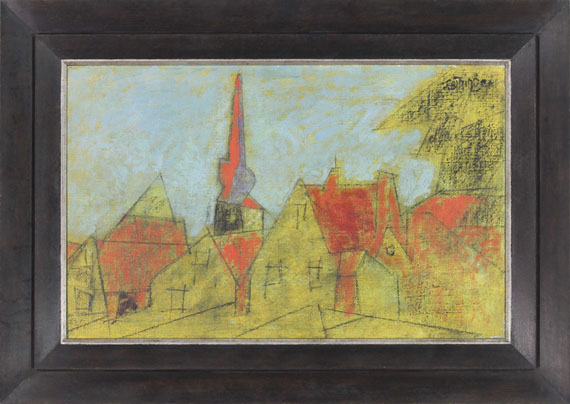266
Lyonel Feininger
Gaberndorf, 1953.
Oil on canvas
Estimate:
€ 150,000 / $ 177,000 Sold:
€ 275,000 / $ 324,500 (incl. surcharge)
Gaberndorf. 1953.
Oil on canvas.
Hess 531. Signed in upper right. Once more signed on the stretcher, as well as dated and titled. 38 x 61 cm (14.9 x 24 in). [SM].
• Gaberndorf is one of the most important motifs in the artist's oeuvre
• Motif after his "nature notes", which are of symbolic meaning for the artist's late period of creation
•Characterized by a dense and rich color effect.
PROVENANCE: Dr. Karl Lilienfeld, New York.
Private collection North Rhine-Westphalia.
EXHIBITION: Feininger im Weimarer Land, Kunsthaus Apolda, 1999.
LITERATURE: Wolfgang Büche, Back in New York - Zurück in einer vertrauten Fremde, in: ex. cat. Lyonel Feininger. Zurück nach Amerika, Stiftung Moritzburg, Halle 2009, p. 11.
Oil on canvas.
Hess 531. Signed in upper right. Once more signed on the stretcher, as well as dated and titled. 38 x 61 cm (14.9 x 24 in). [SM].
• Gaberndorf is one of the most important motifs in the artist's oeuvre
• Motif after his "nature notes", which are of symbolic meaning for the artist's late period of creation
•Characterized by a dense and rich color effect.
PROVENANCE: Dr. Karl Lilienfeld, New York.
Private collection North Rhine-Westphalia.
EXHIBITION: Feininger im Weimarer Land, Kunsthaus Apolda, 1999.
LITERATURE: Wolfgang Büche, Back in New York - Zurück in einer vertrauten Fremde, in: ex. cat. Lyonel Feininger. Zurück nach Amerika, Stiftung Moritzburg, Halle 2009, p. 11.
266
Lyonel Feininger
Gaberndorf, 1953.
Oil on canvas
Estimate:
€ 150,000 / $ 177,000 Sold:
€ 275,000 / $ 324,500 (incl. surcharge)
Headquarters
Joseph-Wild-Str. 18
81829 Munich
Phone: +49 89 55 244-0
Fax: +49 89 55 244-177
info@kettererkunst.de
Louisa von Saucken / Undine Schleifer
Holstenwall 5
20355 Hamburg
Phone: +49 40 37 49 61-0
Fax: +49 40 37 49 61-66
infohamburg@kettererkunst.de
Dr. Simone Wiechers / Nane Schlage
Fasanenstr. 70
10719 Berlin
Phone: +49 30 88 67 53-63
Fax: +49 30 88 67 56-43
infoberlin@kettererkunst.de
Cordula Lichtenberg
Gertrudenstraße 24-28
50667 Cologne
Phone: +49 221 510 908-15
infokoeln@kettererkunst.de
Hessen
Rhineland-Palatinate
Miriam Heß
Phone: +49 62 21 58 80-038
Fax: +49 62 21 58 80-595
infoheidelberg@kettererkunst.de
We will inform you in time.




 Lot 266
Lot 266 

